Comic-Con is just around the corner, so let's squeeze in more Q&A as that seems to be the driving force of this site lately. Let's talk packaging - is it time for the blue refresh of The Black Series? And Star Cases - will they see an update soon? Finally, the toy market in 2014 is different than it was in 1999, 1995, or 1983 because why not.
Also, don't forget to send in your questions for next time. Read on!
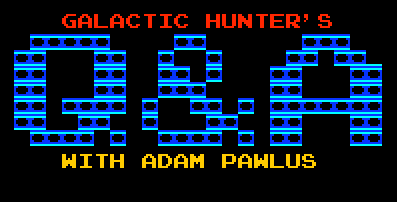
1. Are there new available Star Cases for Black Series 3.75? Or, do they fit into one of the existing five cases I know of?
Same question regarding Indiana Jones toys from 2008-09?
--Allen
I have yet to see a Star Case designed specifically for The Black Series or 2008 Indiana Jones action figures.
The 4 3/4-inch x 9-inch footprint of The Black Series is a unique one shared with the new Marvel Universe line, so there may not be much financial incentive to produce a specific case for these figures. I would suggest trying Star Case 1 and Star Case 2 if you have any to see if it gets a close fit, and I also found they fit inside cases designed to work with 2007-2008's "coin card" 30th Anniversary action figures.
Indiana Jones figures from Hasbro have roughly the same footprint as a 2008 The Legacy Collection figure - so those blue-carded Stormtrooper or Clone Trooper cardbacks are your best bet. I don't have any empty cases handy to test them but they have similar measurements and bubble placement, and are some of Hasbro's last 6x9-inch cardbacks (not counting Vintage). I'd give that a shot.
The proliferation of the Star Case as a product was helped greatly by a much larger pool of collectors than we enjoy today buying more stuff, and with more fans buying (and preserving) packaged figures. Hasbro's move away from 6x9-inch cardbacks makes it less desirable to produce unique size cases for what are shaping up to be smaller, shorter-lived lines and we've seen other major collector lines - like Mattel's Masters of the Universe Classics - do not necessarily have an audience that buys this kind of product, despite requesting it.
If that doesn't work - and you've got cash to spare - a number of collectible case companies make heavy, clear acrylic cases for various collectibles in varying sizes. I would suggest it's a token of your extreme fandom to put them in such a pricey case, given that the case itself may be heavier and more expensive than the figure going in it. But hey, I've seen some pretty crazy things, and if you're loaded who am I to judge?

| Pre-Order Your Toys at Entertainment Earth! |
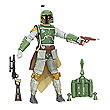  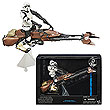 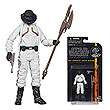 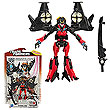  |
| Coming Soon to Entertainment Earth! |

2. What packing does the Yoda-Dagobah Luke-Toryn Farr wave come on? Is it the new packaging with blue stripes, or still the one with the orange stripes? If it's the orange, can I assume the following wave will have the new packaging?
--Greg
The Black Series waves 4 and 5 (which is to say, Yoda, Luke, Toryn Farr, Sgt. Doallyn) so far have only been sighted on the orange-striped The Black Series cardbacks. As of yet, I would not anticipate seeing the blue version until the "Fall" waves start - so August, or later.


3. I read a lot about how Hasbro is responsible for not getting product out to collectors, but how much are the big box stores to blame? Whenever I hit up Wal-mart or Target, it seems like there are more toy lines than ever, but less overall space to carry them, resulting in each line getting just a sliver of the toy aisle. It feels like that if demand for toys are there, they aren't giving them a chance to succeed. Is there no demand? Or do the big box stores not receive enough profit from action figures to care whether demand is there or not?
--Jesse
With action figures, you can blame a lot on a lot - and the truth is everybody is to blame. Action figures used to be driven squarely at kids - they were bought, consumed, enjoyed, destroyed, and largely forgotten. Starting around 1989, speculation on new action figures really kicked into high gear with Toy Biz' Batman range, with newspapers writing stories expecting them to be in short supply and hot stuff before they came out - this fed off other trends in other collectible fields. This continued into the 1990s when we saw lines like Star Trek bought by some kids and tons of collectors, with much higher runs than we see today. Hundreds of thousands were produced, rather than (estimates say) 30,000-100,000 for many major figure lines today - if not less than that.
I mean, look at comic books. In 1990, I was buying them for a buck each, and they were mostly printed on cheap newsprint. Today? $3-$4, glossy covers, the works. Video games have been largely $40-$50 forever, but now we're seeing more download-only games for $20 or under - some are $1. Trading cards went from a thriving industry of cheap card stock backs and some pretty nice glossy fronts in a waxpack of 10 with gum and a sticker for under a dollar to $4 or so for a pack of 5 glossy cards. Collectors demand more, which reduces kid interest, which increases competition for collector dollars, which means a smaller overall market and a smaller pool of disposable income from which to draw. The single greatest thing that can happen to any toy line is a huge surge of kid interest - look at Star Wars LEGO, the LEGO movie, Monster High (about a year ago), Teenage Mutant Ninja Turtles, an so on. There's even a "collector" component to video games - vintage boxed stuff and limited edition new product - but the real cashola to be had is in big games for wide audiences. Niches are a great way to invest a lot of money and lose it - and while some of us can make livings in this space, mega-corporations can't. Star Wars toys must expand or keep trying new things until something works.
The 1980s and 1990s caused big companies like Hasbro and Mattel and Toy Biz (RIP) to expect really big numbers for their wares - and as such, many companies still operate under the mentality that a line must sell ghastly large amounts to be successful. The decentralization of the collector through the loss of single sources of news like ToyFare, Action Figure Digest, White's Guide to Collecting Figures, and Lee's Action Figure News and Toy Review changed a lot too - collectors now subscribe to specific fan sites and blogs that give them the point of view they want. If you like Star Wars, it is unlikely you will somehow stumble on Onell Design, or Transformers, or He-Man. The best analogy I can give you is how news changed from Network Evening News to Fox News, MSNBC, and Comedy Central - you can get what you want, one size no longer fits all. We see the same thing in the music industry - albums just don't sell what they used to. The monoculture is dead, we learn less because we don't care what else is going on in the toy/music aisles.
Because of this (and kids growing up quickly), we've also seen shrinking toy departments - my favorite Walmart used to have an enormous toy section, with separate clearance areas (plural!), and scores of unsold, dirt-cheap product a few times a year. This has ended - their toy section is quite small now, with little new, exciting, or weird. The adult collector customer exists, but they no longer are aware of the entire suite of action toys - they're also buying Sideshow, Hot Toys, Gentle Giant, Matty Collector, and things not in stores. $30-$60 (or even more expensive) figures compete for the $5-$10 collectible dollars. In 1995, if you wanted a Star Wars collectible you had choices like Bend-Em's, MicroMachines, and of course Kenner's action figures. Today? LEGO, busts, statues, 1:6 scale $200 figures, 1:4 scale statues, and more. I should also point out that LEGO has gone from part of a toy aisle, to an entire side of an aisle, to both sides of an aisle in many big box stores since the 1990s - kids love the stuff. LEGO is now the #2 US toy company. The consumer, retailer, and manufacturer are all changing. Remember, action figures used to be 12-inch things with cloth outfits, or bendable things. The 3 3/4-inch articulated man was big in the 1970s and 1980s, and was dead by 1990 - if it weren't for Star Wars and G.I. Joe collector brands, it'd probably not have come back until much later. Like, nowish.
If there were fewer licensors, and fewer products, and kids were on board, and the same collectors weren't still in this, and new collectors came up, we wouldn't have the problems you mentioned. Kenner made almost all Star Wars toys in the old days, and now multiple companies are all competing for decreasingly smaller slices of a pie that hasn't grown much. Many of us have been collecting on and off since we were children in the 1970s and/or 1980s. I haven't met many of the 1990s up-and-comers. I rarely see people younger than I am at big collector events. What we need right now, more than anything, is for the new movies and TV shows to be huge enough hits that it brings people in to collecting new and old toys once more. I do not believe this to be likely on a grand scale, but if you can accept the level we're at now we can probably keep it going - and a little bigger - for quite some time.


FIN
The rumors were true! More online stores and distributors are now selling individual Star Wars figures - and Marvel, and Transformers, and some other stuff. As always, it is a good time to show your support for this kind of thing if you're a fan who has had difficulty obtaining certain The Black Series figures. Over time I've seen everybody from the first three waves in big box stores, but it really has taken quite a while to spread out. The good news here is that Hasbro really does seem to be making an effort to make figures available to fans in some capacity, and I hope they keep doing it for a long, long time.
The big question that keeps being asked is "how long?" Most nostalgia-focused lines come and go, and come and go, and so on. Batman has been revived in many forms while being mostly "on" since 1989. Star Trek has suffered a few undignified hiatuses. Marvel has been pretty steady since 1990 in action figure form, and while Star Wars action figures have been regularly on shelves since 1995, other licensed figures have been on and off since about 1993.
Some lines (and indeed licenses) experience abrupt, massive changes - Star Trek has largely stuck with "classic" since the end of the 1990s, with a few brief forays into whatever was new at the time. Star Wars has many fans looking forward to an end point - or so your emails seem to say - which seems increasingly unlikely. I'd be delighted to see a bold leap in a new direction, a clean break with the past for a few years so we can stop wading in the shallow waters of our childhoods. Star Trek: The Next Generation provides an interesting template of how one can reboot a franchise without abandoning your roots - for a few years, the bulk of the merchandise stuck with the current line, while we enjoyed new stories, new spin-offs, and the era of Kirk was, mercifully, ended.
Star Wars has suffered from more than a few lulls in activity lately, but I think that's more than acceptable. Star Trek ran non-stop from "Encounter at Farpoint" in 1987 to "These Are the Voyages..." in 2005. Granted, the flow of toys and models and stuff wasn't always consistent but there were a few good years in there before what I assume to be extreme fatigue of a sacred text having been expanded from under 80 episodes and 4 movies to roughly 700 live-action installments and 10 live-action movies in fairly short order.
With Star Wars, fans have decided to ignore much of what the franchise has to offer - I don't even mean comics or video games or toys, but the bulk of the franchise has been written off by people. 39 half-hours and 2 telefilms are largely (and intentionally) forgotten, plus we have 3 prequels prone to varying degrees of acceptance and over 100 mostly-enjoyable 20-minute slabs of CG The Clone Wars action. I assume that Star Wars has thrived due to the shirking of what's new - expansions to the original trilogy seem to only make those original movies more loved, not unlike the endless parade of Wizard of Oz sequels and remakes.
While not all of Star Trek can hold up to scrutiny, it's still a massive 700+ installments spanning 48 years and counting. To study it is to get a probably glimpse of a family show - one that does cater to kids in spots, just like Star Wars or Doctor Who - and get a great outsider's look as to what our future may hold. Appealing to kids is a smart move because if you succeed, you get multiple generations of fans.
Another franchise to watch is Marvel. Marvel will be 75 next year and despite some horrible spiteful events like the end of the Fantastic 4, it provides another glimpse of where we could be. Star Trek had two concurrent series on TV each week from 1993 to 1999, and we've seen Marvel go from one or two movies a year to the whopping four-film slate of 2014. There will be two Marvel TV shows next year on ABC, with others in animation. Should the Elder Gods at the House of Mouse deem Star Wars worthy, it is not unreasonable to think that Star Wars could once again evolve into an unescapeable phenomenon in our culture. While that may sound charming, 1999's plastering of Natalie Portman on KFC windows and Darth Maul on Pizza Huts combined with the "event" line-ups at toy stores and movie theaters feel like some of the more shameful events in my life, and I've had more than a few.
We live in an era of the undying franchise. Because Sony owns Spider-Man at the movies, we will never go more than three years without a new one. Disney thinks Star Wars is worthy of, at minimum, annual installments. The good news - potentially - is that Marvel's maturation into a massive movie marketing machine resulted in more conservative toy lines. Fewer waves of figures means less to collect, and right now that sounds like a good move. Simply being able to absorb the media provided to us by Star Wars sounds like a daunting task before shopping trips enter the equation... and it's my sincere hope that Hasbro continues to find ways to make things easier on the collector. I love going to toy stores but mostly to explore - the gambling aspect of gasoline as a losing lottery ticket for my trips to the store is less charming, and the Canada-only figures since late 2012 are not making me a merry man. Marvel feels like it is leaving fans wanting more. I think that, as toys go, this is an attitude we should adopt for our favorite franchise.
--Adam Pawlus
Got questions? Email me with Q&A in the subject line now! I'll answer your questions as soon as time (or facts) permit.